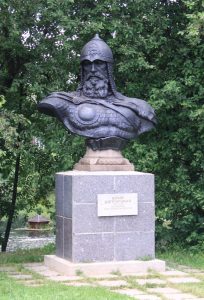
Pereslavl-Zalessky is a city (since 1152) in the Yaroslavl region of Russia. It is the administrative center of Pereslavl district which has the status of a city of regional significance. Within the boundaries of this region, within the framework of the municipal system, since 2018, it forms the urban district of the city of Pereslavl-Zalessky. The city is included in the Golden Ring of Russia. In 2009, the city was visited by 292.6 thousand people, 91% of whom arrived there on an excursion. At the same time, 2% of the tourists (5.8 thousand people) were foreigners.
The Golden Ring of Russia is a tourist route that passes through the ancient cities of North-Eastern Russia, which preserved unique monuments of the history and culture of Russia also play the roles as centers of folk crafts. This fact explains why there are so many monuments can be found around the city.
1. Monument to Alexander Nevsky
One of the main monuments of Pereslavl-Zalessky – the Monument to Alexander Nevsky – is located in the heart of the ancient city, in the center of Red Square.
Once upon a time, on the Red Square there were princely chambers, where in 1220 the second son of the Pereyaslav prince (later – the Grand Duke of Kiev and Vladimir) Yaroslav Vsevolodovich was born – Alexander Nevsky. In the Transfiguration Cathedral, the future famous Russian commander was baptized. In 1241, from here, from Red Square, the prince, together with the Pereslavl squad, went to battle with the Livonian knights. Therefore, the appearance of the monument in this place is not accidental.
The monument, made by an outstanding sculptor, People’s Artist of the RSFSR Sergey Mikhailovich Orlov, was opened in 1958. The monument, whose total height is about two meters, is a bronze bust of Alexander Nevsky, mounted on a pedestal lined with granite slabs. The prince is depicted in chain mail and a helmet; his gaze is fixed on the distance. For more than half a century, the monument to Alexander Nevsky has been one of the symbols of the city, inextricably linked with its rich history.
2. Transfiguration Cathedral
The cathedral was founded in 1152 by the founder of the city, Yuri Dolgoruky, and is one of the main attractions not only of Pereslavl, but of the whole of North-Eastern Russia. This is one of the most ancient architectural monuments of the pre-Mongol period – in comparison with the elegant temples of Western Europe; the cathedral is very ascetic and resembles a stern warrior who defended his native land.
Very few survived from the once rich interior of the temple during numerous fires and ruins – fortunately, the most valuable temple icon “Transfiguration” of the 14th century, presumably the work of Theophanes the Greek, has survived to this day.
3. Monument to Peter the Great
Commemorative stele “Peter the Great” – was opened in 1852, architect P.S. Campioni. The stele is made of Finnish granite and decorated with bronze sea symbols – anchors, chains – and construction (axes), the inscription is written in gold on the top: “Peter the Great”, below, on the pedestal, the story of the monument’s installation is told. The monument was laid two years earlier by the Grand Dukes Nikolai and Mikhail Romanov, sons of Nicholas I, when visiting Pereslavl.
4. Blue Stone
According to legend, the Blue Stone of Pereslavl-Zalessky is located on the site of an ancient pagan temple. After the adoption of Christianity by Rus, the adherents of the new faith repeatedly threw the Blue Stone into the water in order to stop the conduct of pagan rites, but soon he somehow again appeared on the shore. Local materialists consider this an ordinary physical phenomenon related to the peculiarities of freezing and melting of water in the lake. Nevertheless, the Blue Stone is nowadays covered with many pagan legends and mystical traditions.
5. Monument to Yuri Dolgoruky
The monument to the founder of Pereslavl-Zalessky – Yuri Dolgoruky – is another work (as well as the monument to Alexander Nevsky) of the famous Soviet sculptor Sergei Mikhailovich Orlov. This is a repetition of a fragment of the famous monument to Yuri Dolgoruky on Tverskaya Square in Moscow. A bronze bust was originally installed in the central hall of the Museum of History and Reconstruction of Moscow, and in 1963 it was transferred to the Pereslavl Museum-Reserve and installed in a garden on the territory of the Goritsky Monastery, in which the museum is located.
5. Assumption Goritsky Monastery
A legend is associated with the Goritsky Monastery: two years after the defeat in the Battle of Kulikovo, the Tatars, led by Khan Tokhtamysh, again invaded Russia and subjected it to utter ruin. Shortly before the invasion, here, in the Goritsky monastery, Grand Duchess Evdokia, the wife of Dmitry Donskoy, came for pilgrimage. The princess escaped by a miracle – the monks and her entourage put her on a raft and he hid behind a thick fog in the middle of the rescue Pleshcheev Lake. In memory of her miraculous salvation, Evdokia at personal expense 10 years later restored the Goritsky monastery destroyed by the Tatars. Since then, there has been such a tradition in Pereslavl-Zalessky: on the sixth Sunday after Easter from the Goritsky monastery in the middle of the lake, a procession in boats is arranged.
6. Holy Trinity Danilov Monastery
The current monastery was founded in 1508. The founder and first rector was Elder Daniel, known as the godfather of Ivan the Terrible. The main temple of the monastery – Trinity Cathedral – was built in 1530, during the life of St. Daniel and is the second oldest building of Pereslavl after the Transfiguration Cathedral. Trinity Cathedral was built at the behest of Tsar Vasily III in honor of the birth of the heir – the future Ivan the Terrible.
